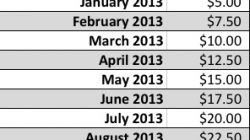US Bank officially dipped its toe into the premium rewards card market with the launch of the “Altitude Reserve” card today. I’ve put together a recap of the card’s benefits and how they compare to other popular travel rewards cards. I’ll also give my verdict as to whether this card is worth applying for.
US Bank Altitude Reserve – Benefits
Among others, the Altitude Reserve includes the following benefits as part of its $400 annual fee:
- Sign-up bonus of 50,000 points after you spend $4,500 on eligible purchases within 90 days of account opening.
- $325 annual travel credit per cardmember year for purchases made directly through airlines, hotels, car rental companies, taxis, limousines, passenger trains and cruise lines.
- 12 complimentary Gogo in-flight Wi-Fi passes per year.
- A discount of 15% as well as $30 off your first ride with GroundLink Black Car Service.
- Pre-sale access and $60 off per person per event with the James Beard Celebrity Chef Tour.
- Ability to use points for flight time as well as flight time and aircraft upgrades with NetJets Private Aviation.
- Priority Pass Select membership, with four free visits for the cardmember and one guest each year.
- Benefits at Relais & Chateaux Boutique Luxury Hotels including accelerated access to the Club 5C loyalty program after two nights stayed. Benefits of Club 5C include “room upgrades, personalized services and invitations to exceptional cultural and culinary experiences; and a complimentary breakfast daily at approximately 120 participating properties.”
- Receive up to 30% off Silvercar rentals of two days or more when paying with the Altitude Reserve.
- $100 statement credit towards a Global Entry or TSA PreCheck application fee.
- Complimentary continental breakfast, automatic room upgrade when available, $25 food or beverage credit and more when booking hotels that are part of the Visa Infinite Luxury Hotel Collection with the Altitude Reserve.
- No foreign transaction fees.
As far as points earning/burning, the Altitude Reserve offers the following earn & burn structure:
- 3x points on all travel purchases directly with the travel provider. This includes airlines, hotels, car rental companies, taxis, limousines, passenger trains and cruise line companies.
- 3x points on all mobile wallet purchases (i.e. Apple Pay, Samsung Pay, Android Pay or Microsoft Wallet). Purchases can be made in person, in an app or online as long as they are processed through the Digital Wallet.
- 1 point per dollar spent on all other purchases.
- No caps on point earnings per year, either by category or in total.
- Points are redeemable for a statement credit of 1 cent per point on any purchases, or 1.5 cents per point on travel purchases booked using the US Bank travel portal.
- Altitude points DO NOT TRANSFER to other airline/hotel programs at this time.
The other significant catch: you must already be a US Bank customer to apply at this time. The bank defines “customer” liberally, including home mortgage and car loan customers. However, if you don’t already have an account with US Bank, you must wait one month after account opening to apply.
US Bank Altitude Reserve – Comparison to Other Cards
A Basic Earnings Chart
I’ll start with a simple table showing net benefits for a hypothetical $15,000 of spending. This assumes you apply for all of these cards and get approved tomorrow. Then, you spend $5,000 on travel, $2,500 on dining, and $7,500 on other spend through April 30 of next year. Travel consists of half airfare and half other. I assume you’ll qualify for the sign-up bonuses. I also assume you’ll redeem directly for travel, and not by transferring points where available. Finally, I ignored the value of other benefits, since they’re difficult to quantify. Yes, it’s unrealistic and oversimplified. But trying to map out all the possibilities is too complicated for this post. More on why I picked these cards later.
| Altitude Reserve |
CSR | Citi Prestige | Amex Plat | Cap One Venture | Barclays Arrival Plus | |
| Travel | 15,000 | 15,000 | 15,000 | 20,000 | 10,000 | 10,000 |
| Dining | 2,500 | 7,500 | 5,000 | 2,500 | 5,000 | 5,000 |
| Other | 7,500 | 7,500 | 7,500 | 7,500 | 15,000 | 15,000 |
| Sign-up | 50,000 | 50,000 | 40,000 | 60,000 | 40,000 | 50,000 |
| Total | 75,000 | 80,000 | 67,500 | 90,000 | 70,000 | 80,000 |
| Point value | 1.50 | 1.50 | 1.33 | 1.54* | 1.00 | 1.00 |
| Total reward value | $1,125 | $1,200 | $897.75 | $1,386 | $700 | $800 |
| Travel credits | $325 | $600** | $500** | $400** | $0 | $0 |
| Less AF | -$400 | -$450 | -$450 | -$550 | -$59 | -$89 |
| Net Benefit | $1,050 | $1,350 | $947.75 | $1,236 | $641 | $711 |
* See link to Amol’s article below on how to value the Amex travel benefit. Yes, it’s complicated.
** Credit awarded on a calendar-year basis. You can therefore claim two credits in the first cardmember year.
On this basis, the Altitude Reserve fares competitively to other premium cards, though it isn’t a game changer. It potentially is a better value than traditional travel “cash back” cards, though. Also, as noted below, the mobile spend category could goose the value significantly. (Note: I acknowledge that netting travel credits from the annual fee is controversial, as is claiming “value” for taking two credits in the first membership year. I won’t address the arguments for and against here. Ultimately, it doesn’t materially change the outcome of the analysis, anyway)
A Detailed Analysis
Of course, the primary selling point of this card is the $325 annual travel credit. On paper, this looks like a great deal, as it exceeds the credits offered by its competitors. Chase offers only $300 with the Sapphire Reserve; Citi $250 with the Prestige, limited to airfare only; and Amex $200 with the Platinum card, restricted to “fees” on a single airline. However, before applying, keep in mind that the credit accrues per cardmember year, not calendar year. With the Prestige, for instance, you can utilize $500 worth of credits before the annual fee comes due. Not so with the Altitude Reserve.
The actual travel portal benefit compares favorably with other programs. Chase matches with 1.5 cents per point, while Citi offers 1.33 (1.6 on American through June 23rd). Amex currently effectively offers 2 cents per point through the 50% rebate. However, that soon decreases to 1.54 cents/35%, plus you have all the hoops to jump through to get it.
I’m not enamored, though, with the requirement to use the US Bank travel portal to redeem travel rewards. As Amol noted earlier, the dreaded Basic Economy fares plague bank travel portals. What’s worse, overriding Basic Economy proves difficult, if not impossible. Also, hotels greatly restrict elite benefits for portal bookings, significantly reducing the value of that “free” room. Granted, that only places US Bank on equal footing with Amex, Chase, and Citi. All three also require using their portals to redeem travel rewards directly. Compare, though, to the Capital One or Barclays. Although both offer only 1 cent per point, you can apply the credit to ANY travel purchase, offering much more flexibility.
On the other hand, I find the 3x points on “mobile wallet” purchases intriguing. In theory, that opens up the possibility of triple points on all purchases. That creates a lot of potential value if you’re a big spender. Any retailer that accepts Apple Pay, for example, earns triple points, or an effective 4.5x return on travel. As a new dad who donates far too much of his paycheck to baby gear, the ability to earn that return at Babies “R” Us every day certainly appeals to me. Amex, Chase, and Citi occasionally offer bonuses at retailers, though only on a targeted, limited-time basis. One limitation: before you MSers start licking your chops about buying gift cards through a mobile wallet, beware the T&Cs:
Qualifying purchases do not include Convenience Checks, Advances (including, but not limited to, wire transfers, traveler’s checks, money orders, foreign cash transactions, betting transactions, lottery tickets and ATM disbursements), Balance Transfers, Interest Charges and Fees, credit insurance charges, transactions to fund certain prepaid card products, U.S. Mint purchases, or transactions to purchase cash convertible items.
This suggests gift cards are ineligible for 3x earnings. However, the same is technically true of using the Amex “fee” credit to buy airline gift cards, so YMMV. Also, before you ask – no, you can’t “double dip” by charging travel purchases to a mobile wallet. You only earn the 3x points once, not twice.
As far as other benefits, there’s an assorted grab bag of stuff, some interesting, some not. As an amateur foodie, the $60 discount on James Beard events seems interesting. The GoGo passes are nice, though I don’t value these at face given how unusably slow the service is. Not to mention, I already get one hour free as a T-Mobile customer. The Priority Pass membership offers little value for frequent flyers, since only four visits are free. The others might or might not interest you depending on how you travel.
Of course, the biggest downer is the lack of transfer partners. In essence, that makes the Altitude Reserve a souped up travel cash back card, more like the Capital One Venture or Barclays Arrival Plus. As mentioned, neither require booking through a portal, thus providing better flexibility.
US Bank Altitude Reserve – My Verdict
I have a car loan through US Bank, and qualify for some personal loans for fair credit, so I could apply if I want to. Will I? At this time, probably not. The Altitude Reserve is something of a hybrid between a premium rewards card and a travel cash back card. The possibility of earning 3x points on everyday purchases via Apple Pay is interesting. However, the lack of transferability, combined with having to use US Bank’s portal to redeem points for travel, is a deal killer for me. Theoretically, you could book your own travel and take a statement credit at 1 cent per point. But at that point, the value proposition is basically the same as a card like Capital One Venture. I already have a couple of cash back cards that do that, and I don’t see enough here to justify forking over another annual fee.
That being said, I’m going to keep an eye on this card. If Sam’s Club and Kroger (my preferred grocer) start accepting Apple Pay, getting triple points at both year-round might be too good to pass up.




